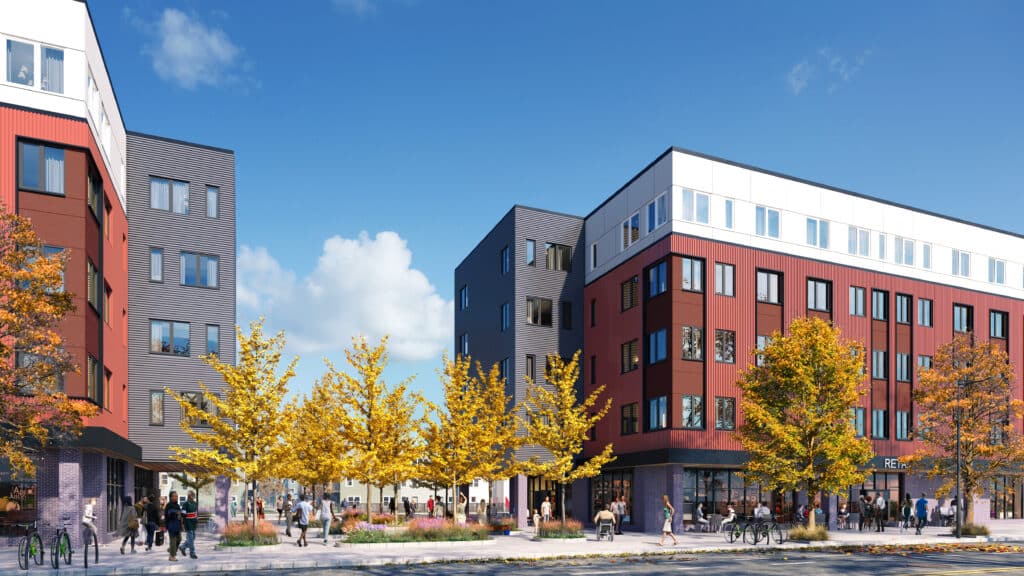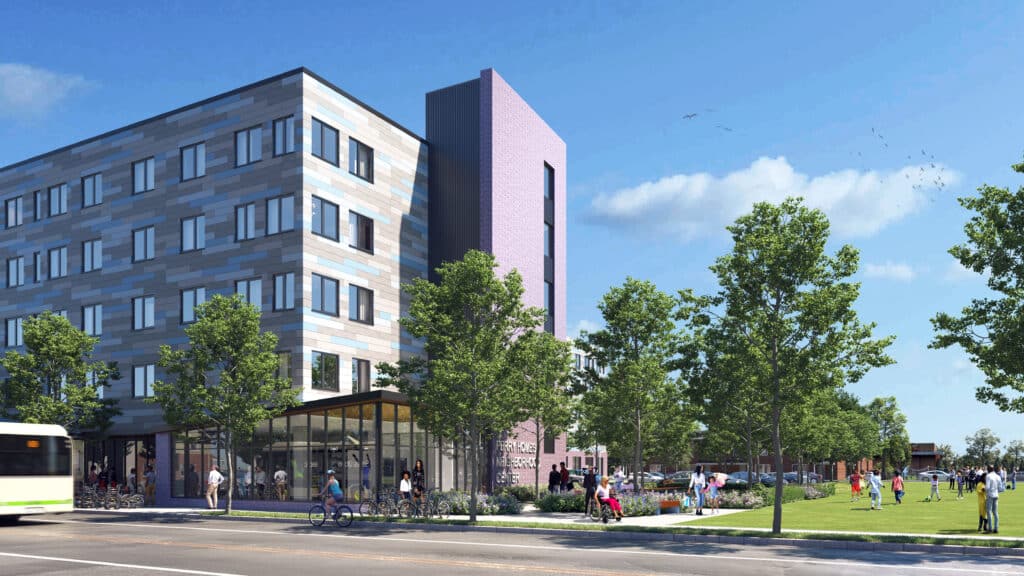Affordable Multifamily Goes Electric in the Empire State
A Major Public Housing Renovation in Buffalo Proceeds Under New York’s New All-Electric Construction Mandate

By Ethan Finlan
11 min read
In 2022, New York State announced that it would require new and rebuilt high-rise buildings to be fully electric-powered to meet emissions reduction goals. Simultaneous to this mandate, the City of Buffalo’s housing authority began rebuilding one of its largest complexes, the long-dilapidated Commodore Perry Homes. The new project, which seeks to meet the state’s energy efficiency standards, will be entirely electric-powered. While this mandate makes the project a more substantial undertaking, housing authority and developer representatives say that state and financing partners have greatly aided the construction process and are broadly optimistic about the future of all-electric affordable multifamily construction.

Project Background
Spanning roughly six blocks, the Perry site was one of the state’s longest-operating public housing complexes, says Gillian Brown, executive director of the Buffalo Municipal Housing Authority (BMHA). “When [the Perry complex] was built in 1939-1940, it was built pretty well in terms of a housing concept at that time,” according to Vera Kiselev, redevelopment project manager with Wallace Roberts & Todd (WRT), and it included significant public open space.

But by the 2010s, the site had become unlivable, prompting scrutiny from a local congressman and the Department of Housing and Urban Development. With the announcement of the first redevelopment phase, Sen. Charles Schumer said the complex has “for too long…been an eyesore in Buffalo’s First Ward neighborhood.”
The complex was emptied by attrition, and some buildings had been closed for ten years by the time BMHA was able to relocate the few remaining tenants. “People were just not willing to live in these buildings, period,” Brown says. Over time, they simply “became impossible to maintain,” and the last building closed in 2018.

While a 1999 HOPE VI grant award let the agency demolish part of the complex, it lacked the funding to complete the job. “The housing authority [used existing funds] from federal resources to slowly board up and stabilize the properties,” says Dylan Salmons, regional vice president at Pennrose, lead development partner in the project. That changed last year with a $5 million grant award from the Restore New York program, an economic growth initiative focused on funding the redevelopment of dilapidated buildings. Demolition began in April, and the first round of apartments is on track for a summer 2025 opening, according to Salmons.
The project is being built by Pennrose and the BMHA’s nonprofit developer, Bridges Development. According to a Pennrose press release, the completed project will include over 400 affordable apartments, across 27 buildings, three of which will be mid-rise buildings with retail space; the remaining buildings will be townhomes. The full phase 1 redevelopment will take three years to complete.The tenant income threshold is at or below 60 percent of the area median income (AMI), and over 280 of the units are set aside for Section 8 Project-Based Housing.
The redevelopment is happening in the context of New York’s Housing Plan, a $25 billion effort to build and upgrade 100,000 affordable units statewide. “With this investment, we are transforming the Perry Homes site from a symbol of decline and decay to a symbol of rebirth and resurgence,” Gov. Kathy Hochul said, adding the project would “[increase] state-of-the-art affordable housing options in Buffalo.”
The Impact of Electrification
Starting in 2026, most new buildings in New York of seven or fewer stories will be fully electric. This measure is the result of the state’s Climate Leadership and Community Protection Act, which according to the state’s Homes and Community Renewal Department (HCR) “mandates at least a 40 percent reduction in greenhouse gas emissions by 2030 and at least 85 percent reduction by 2050, compared to New York State’s 1990 carbon emission levels.” Making buildings greener has long been a priority of climate change mitigation advocates. According to the National Resources Defense Council, buildings are New York’s main carbon emissions source.
When the requirement was first proposed, The City reported, members of the development and real estate communities expressed concern over insufficient grid capacity and limited technological progress for such a mandate to be viable, highlighting the fact that power would still come mainly from fossil fuels.
The all-electric requirement added costs to the Perry project, says Bridges Development President Nadine Marrero, who estimates a six- to seven-figure additional cost to go all-electric. But New York State has provided ample subsidy to meet the premium. “They understand that the changing costs, the increased direct costs…[are] gonna take additional subsidy, additional tax credits. Long term, hopefully, the grid will catch up and this demand and these costs will go down,” Marrero says.
Proponents argue that all-electric construction saves on both construction and operating costs. A report by Redwood Energy states that projects in California can save around $3,300 per unit by eschewing gas-associated infrastructure needs, shaving $20,000 from an eight-plex. “In the downtown of a city like Los Angeles, just trenching and piping gas to an apartment building in a busy street can cost $140,000,” the report says. Another California study found that all-electric construction “is cost-effective for different multifamily building types”

Some Perry tenants, previously powered mainly by natural gas, expressed concern about getting adequate power in the event of a storm, Marrero says. “All-electric is newer to Buffalo; it’s an education campaign.” Getting an adequate power supply to the new complex will require working with utilities. However, officials believe the complex’s design will conserve heat during a power outage. WRT has extensive experience with all-electric and energy-efficient construction; according to principal in charge Joe Healy, “we’ve been on that sort of front edge of pushing for all-electric projects ourselves…cities and states are sort of catching up to that.”
Looking broadly, Salmons notes a need for collaboration between developers and utilities is key to easing the transition to all-electric operations, “to understand the level of support necessary to run fully electric buildings, including electric car chargers and all the other electric components of the project.”
Design Considerations
As a rebuild, the Perry Homes project must comply with the “New Construction” requirements under HCR’s Sustainability Guidelines, which also outline standards for adaptive reuse and both “substantial” and “moderate” rebuilds. In sum, in addition to the fully electrified requirement, New Construction must use similar energy measures as non-residential construction and adhere to one or more of the guidelines’ “baseline requirements.” HCR aims for all new subsidized buildings to be fully “carbon neutral” by 2027.

Salmons notes that to meet energy efficiency requirements, “every apartment will be equipped with air source heat pumps for air conditioning and heating,” along with appliances meeting ENERGY STAR standards. The property will conform to Enterprise Green Communities 2020+ standards; “the buildings are designed to be zero energy ready” with HVAC and windows designed for this purpose, Kiselev says.
With what Healy calls a longstanding relationship with Pennrose and a presence in Buffalo, WRT undertook an intense community engagement effort during the master planning and design process. “Over the past decade, residents felt that the promises that were given to them [at the time of the HOPE VI grant] were not fulfilled” as the project fell into disrepair, Kiselev emphasizes.

In addition to the energy efficiency and electrification considerations, WRT aimed to integrate the site’s heritage and the desires of residents. “There was a cultural landscape history to Perry and there was a historic pride,” says Zuzanna Drozdz, a landscape designer with WRT, especially surrounding the plants on site. “People thought of this place as a place that had gardens,” and WRT sought to incorporate those aspects, adding open space, “while…moving us into a new 21st-century paradigm.” At the same time, Kiselev says, residents didn’t want to keep the design of the original buildings themselves, motivating the townhouse choice.
Healy notes that the panels for the complex’s mid-rise structures are being built modularly by Baltimore-based Blueprint Robotics. They will include elements from cross-laminated timber. “[The construction] approach is kind of a hybrid modular where all the inspection will still be done on-site, but you’re getting this speed of construction, Healy says. “The quality of the construction, the precision and the waste reduction on-site is just amazing…this approach aligns with our broader sustainability goals through precise planning, execution, saving resources and minimizing our environmental impact.
“The site and building layout had to work within the set geometry of the existing street and alley public rights-of-way,” Healy says and notes that the firm’s experience with designing on demolished parcels aided in the process. WRT’s master plan is also responsive to the adjacent highway by providing “a bigger buffer” between the units and the highway.
The complete project will include car and bike parking with 30 electric vehicle chargers, along with gyms, community rooms and laundry facilities on all floors. Salmons says the developers intend to market the community’s commercial sites to local entrepreneurs or nonprofits that will directly benefit and serve Perry’s new residents.
Funding Sources
The project’s unique needs didn’t deter investors, Marrero notes. “There were multiple investors interested in it. We had at least three offers that came in.” The project will have “healthy rent” support, particularly with the presence of project-based vouchers.

“Utilities are the highest controllable cost of any affordable housing project,” says Brett Macleod, executive director on Chase’s Community Development Banking team, one of the project’s lenders, saying the firm would support additional energy-efficient projects. “[T]he more energy efficient our developments are the lower the energy costs. This lowers rental pricing and delivers more affordable projects to the community.”
Chase provided a $124.4 million construction loan and a $22.6 million Fannie Mae permanent loan to finance the new construction. Macleod adds, “Our main priority is bringing more units to our communities – we want to play a part in helping to fill the affordable housing gap in 2024 and beyond.”
Nearly half of the cost is covered by a Low Income Housing Tax Credit allocation, from both New York and federal sources; Salmons estimates around $110 million of the funding comes from total tax credit equity. Further funding came from $21.9 million in tax-exempt bonds, over $1 million in Community Development Block Grant money and $5 million in Rental Assistance Demonstration Rehab Assistance. In addition to the Restore New York grant, state and local funding includes $83.1 million from the Homes and Community Renewal Authority, $5 million from Empire State Development and $6 million from BMHA’s capital funds.
The project is “meeting policy objectives through combining the benefits of various state and federal initiatives for financing,” says Salmons, calling the tax credit financing in particular “a material part of the capital stack.” He agrees with Marrero that New York state has been significantly helpful, particularly crediting HCR and the state’s Housing Finance Agency. “I don’t think we could have designed, entitled and gotten to closing within 13 months on a project of this complexity without a really great financing partner in those agencies.”
The project also received 45L tax credits, which are geared towards funding energy-efficient projects. Both single- and multifamily construction are eligible thanks to an expansion under the Inflation Reduction Act, which also boosted the credit per unit from $2,000 to $5,000. While 45L credits previously cut into a project’s LIHTC-adjusted basis, buildings can now be financed from both sources. Still, Salmons emphasizes, “a myriad of factors” are involved in whether projects are using 45L credits for all-electric projects, such as credit payment timing, and the current state of equity funding means there is “some uncertainty ahead of us.” Developers should note that credit applicability is tied to wages and eligible projects must follow Zero Energy Ready Home standards.
***
The Perry project will be Buffalo’s first rebuild under the new mandate, Brown says, noting that the city “has some of the oldest [operating public housing] stock in the country.” Two major projects are already in planning.
Pennrose is working towards electrification for its New York portfolio; currently, the firm is working on an all-electric project in the Hudson Valley city of Kingston. “I think there’s been a tremendous amount of competition in the markets in terms of both the manufacturers of the appliances, the trades and of the specialization to install them,” Salmons says.
But the most immediate impact of the rebuilt Perry Homes will be a far better quality of life for its residents and abutters than its predecessor. “For us, [the all-electric mandate] was just a byproduct of the really important part, which was to get these buildings down and rebuilt,” Brown concludes. “It’s in a difficult declining neighborhood that we’re hoping [the new buildings will] help to stabilize and help to revitalize.”
